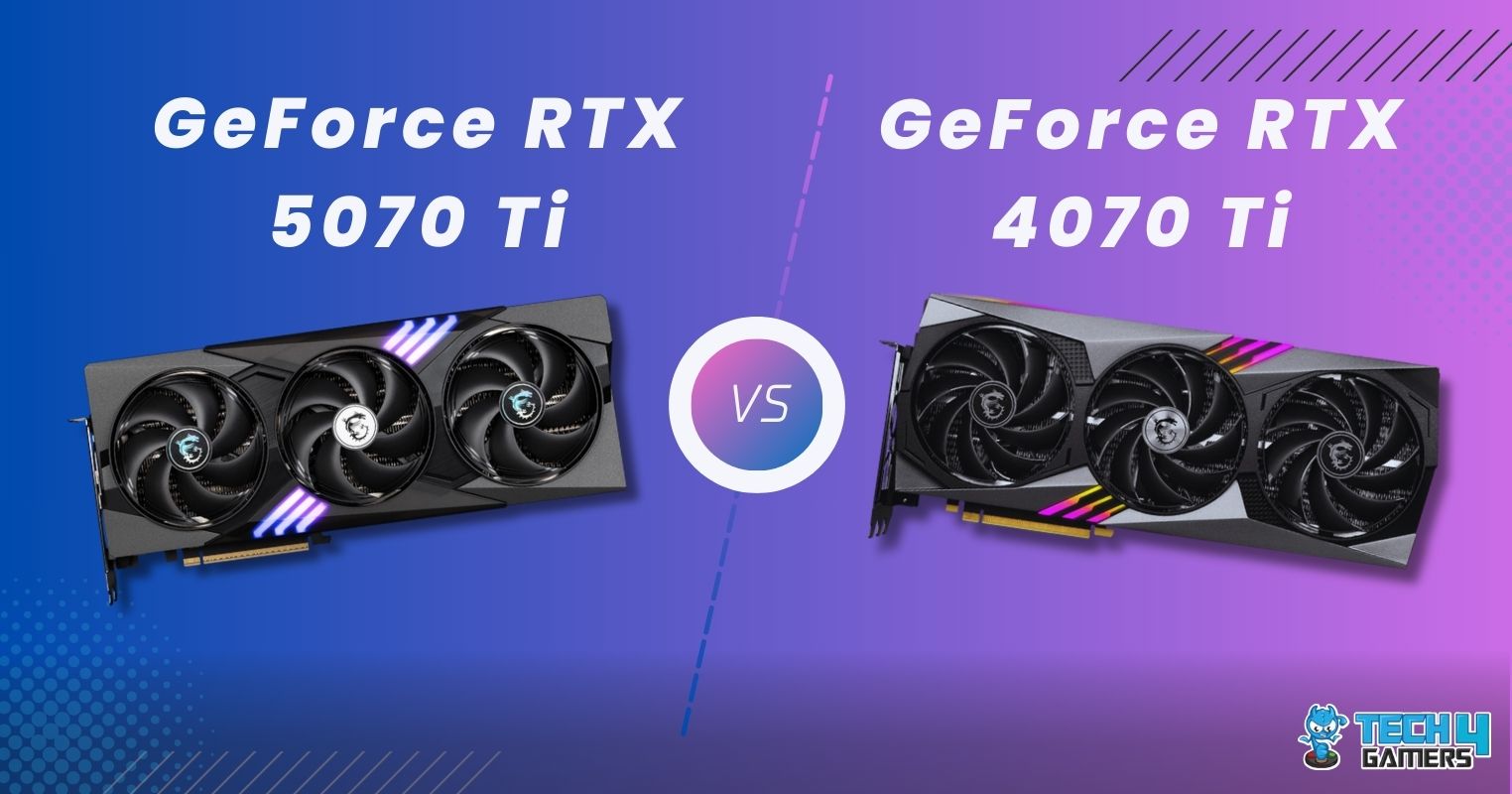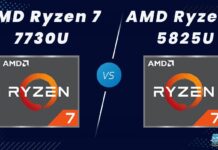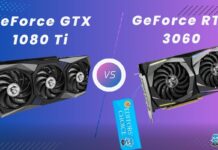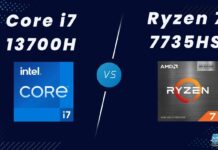If you’re looking to sport one of AMD’s mid-to-high range GPUs, then the RX 6750 XT and RX 6800 XT have probably been on your radar. But with a $100 difference in launch MSRP, which card has better value? Find out as we compare RX 6800 XT vs RX 6750 XT.
Key Takeaways
- The RX 6800 XT performed 23.7% better than the RX 6750 XT in our 1440P gaming tests.
- Power consumption and thermal efficiency favored the RX 6750 XT, as it showed 26.1% and 15% better results, respectively.
- The RX 6750 XT provides a much better value at 27.9% as it’s about 51% cheaper than the RX 6800 XT.
Comparison Table
| GPU | RX 6800 XT | RX 6750 XT |
|---|---|---|
| Architecture | RDNA 2 | RDNA 2 |
| Die | Navi 21 | Navi 22 |
| Processing Node | TSMC 7nm | TSMC 7nm |
| Memory Bandwidth | 512.0 GB/s | 432.0 GB/s |
| Memory Clock (Effective Memory Clock) | 2000 MHz(16 Gbps) | 2250 MHz(18 Gbps) |
| Bus Width | 256-bit | 192-bit |
| No. of Shaders | 4608 | 2560 |
| No. of TMUs | 288 | 160 |
| No. of ROPs | 128 | 64 |
| No. of CUs | 72 | 40 |
| Best Variants | Best RX 6800 XT Cards | - |
Architectural Differences
- Clock Speeds: The two GPUs have a major contrast in the form of clock speeds. The Radeon RX 6800 XT has a memory clock speed of 2000MHz while the RX 6750 XT betters that with 2250MHz. As for core clock speeds, the RX 6750 XT (2150MHz at base, 2600MHz at boost) stands out again over the RX 6800 XT (1825MHz at base, 2250MHz at boost).
- VRAM: The RX 6800 XT has an advantage in terms of video memory and boasts 16GB of GDDR6. Meanwhile, the RX 6750 XT has 12GB of GDDR6 of VRAM.
- TDP: As for thermal design power, the heatsink of RX 6800 XT is designed to dissipate 300 watts at most. The RX 6750 XT is less power-consuming, at 250 watts.
- Supported Technologies: Both cards support AMD’s upscaling technology, FSR.
Gaming Benchmarks
There is no better way to tell the difference between two graphics cards than to test their performance in real-world gaming scenarios. To achieve this, we put both cards into our test bench one by one to benchmark a wide array of games. the specifications of this test bench are written below:
Test Bench
- OS: Windows 11
- CPU: Intel Core i7-13700K
- Motherboards: ASRock Z790 Taichi Lite Motherboard
- RAM: Kingston Fury Renegade RGB DDR5 32GB 7200MHz
- SSD: XPG GAMMIX S70 BLADE 2TB NVMe SSD
- PSU: Enermax Revolution D.F. X 1050W
- CPU Cooler: MSI MAG CORELIQUID E360 CPU Liquid Cooler
Horizon Zero Dawn

- The RX 6800 XT begins proceedings with an average framerate of 115 FPS in our test of Horizon Zero Dawn, while the RX 6750 XT trails far behind with 82 FPS.
- Moving to the %1 lows, the RX 6800 XT managed 95 FPS in reply to 70 FPS of the Radeon RX 6750 XT. The higher-tier card had a noticeably smoother performance in our run of this game.
Cyberpunk 2077

- Moving on to our stroll in the city of Cyberpunk 2077 with FSR enabled, the RX 6800 XT averages a healthy 109 FPS, while the RX 6750 XT had an average framerate of 74 FPS. The RX 6750 XT trailed by 36.2%.
- Regarding %1 lows, the RX 6750 XT caught up slightly with its more powerful brother and scored 62 FPS. Still, the Radeon RX 6800 XT remained ahead by 19.3% with a framerate of 80 FPS.
God Of War

- The RX 6800 XT averaged a perfectly even 100 FPS while we tested God of War, continuing its reign at the top. In contrast, the 6750 XT gave an average performance of only 73 FPS.
- Looking at the %1 lows, the RX 6800 XT keeps going and scores 89 FPS. In contrast, the AMD Radeon RX 6750 XT scored 61 FPS.
Red Dead Redemption 2

- Similar to God of War, the AMD RX 6750 XT scored 73 FPS in reply to 100 FPS of the RX 6800 XT in our test of RDR2 in Valintine City.
- As for the %1 lows, the RX 6800 XT continues to lead with 77 FPS. Meanwhile, the RX 6750 XT fell just below the 60 FPS mark.
Grid Legends

- In our test of Grid Legends, the Radeon RX 6800 XT racked up 189 FPS, leading the RX 6750 XT by 30.3%, which had an average framerate of only 145 FPS.
- The RX 6800 XT fell to 143 FPS as far as the %1 lows are concerned but kept its lead against the RX 6750 XT, which had a minimum framerate of 107 FPS.
Dying Light 2: Stay Human

- Our next benchmark puts the two GPUs against each other in Dying Light 2: Stay Human. Here, the RX 6800 XT averaged 108 FPS compared to 73 FPS of its competitor.
- As for the %1 lows, the RX 6800 XT scored 89 FPS — 41.2% higher than the RX 6750 XT’s minimum fo 63 FPS.
Forza Horizon 5

- In our benchmark Forza Horizon 5, the RX 6800 XT maintained its lead with 136 FPS on average, while the 6750 XT came across with an average framerate of only 110 FPS.
- The RX 6800 XT showed a %1 low figure of 111 FPS over 94 FPS of the competing RX 6750 XT.
Call Of Duty: Warzone

- Our test of Warzone did not take kindly to the RX 6750 XT, which had an average framerate of 143 FPS, while the newer card came across with 188 FPS.
- Somehow, the lower tier card had a higher number in 1% lows, hanging around 100 FPS, while the RX 6800 XT had a minimum of 95 FPS.
Overall Gaming Performance
Having concluded the benchmarks, here’s a look at the overall figures shown by both AMD cards.

The Radeon RX 6800 XT averaged 131 FPS across the eight titles we tested, while the RX 6750 XT fell short with 97 FPS on average. This comes out to be a 34.75% increase in performance for the RX 6800 XT. This is a difference that would be immediately noticeable to most users.
In terms of the %1 lows, the RX 6800 XT scored 95 FPS on average. The RX 6750 XT dipped out at around 77 FPSon average in our tests.
Power Consumption

The RX 6800 XT consumed 243 watts of power on average across the eight tests. Conversely, the RX 6750 XT averaged 191 watts of power consumption.
This makes the RX 6750 XT 26% more power-efficient than the RX 6800 XT, as far as 1440P gaming is concerned.
Both cards consumed much less than their maximum TDP rating while also maintaining a higher difference (26.1%) than the difference in their ratings. (20%)
Thermal Performance

The Radeon RX 6800 XT averaged a temperature of 75.1°C across the eight benchmarks, whereas the RX 6750 XT averaged 65.3°C.
Hence, the RX 6750 XT proved 15% more thermally efficient than the RX 6800 XT in 1440P gaming.
Costs And Availability
Let’s talk about the RX 6800 XT first. It received an (unofficial) $150 price cut from its launch MSRP of $649, to $499. At the time of writing this, two of XFX’s variants (Speedster Merc 319 and Speedster Merc 319 CORE) are available for this $499 price tag. A few other variants are also available, albeit at a slightly higher price tag.
As for the RX 6750 XT, it also received a massive unofficial price drop to $329. However, only one variant (MSI Gaming X Trio) is available at that price. Most other variants are between the $350 and $400 range, which is still a really good price!
The electricity costs should also be considered, as the RX 6800 XT consumed 26.1% more power during our tests.
What We Recommend
Despite the seemingly small difference between the two cards indicated by their model numbers, they have quite a big performance and price gap. The decision to get either card relies solely on your budget.
If you want to get a graphics card which will get you by on 1440p, the 6750 XT is not too shabby.
If you have the budget for it, the RX 6800 XT gives you exceptional performance for a reasonable price.
Pros And Cons
| CPU | Pros | Cons |
|---|---|---|
| RX 6800 XT | Superior 1440P gaming performance | More power hungry Unimpressive thermal performance |
| RX 6750 XT | Better price-to-performance ratio Impressive thermal and power efficiency | Less VRAM |
More From RX 6800 XT
More From RX 6750 XT
Thank you! Please share your positive feedback. 🔋
How could we improve this post? Please Help us. 😔
[Hardware Reviewer]
Hi! I’m Ali Tauseef, and I have been writing for Tech4Gamers since 2022. I love all things computer hardware but am particularly fond of CPUs and motherboards, and I like to stay up-to-date about the latest advancements in these worlds, and when possible, write about it. When I’m not doing that, I like to get into a little FPS action in CS2 or get lost in the vast world of RDR2.
Get In Touch: ali@tech4gamers.com


 Threads
Threads



